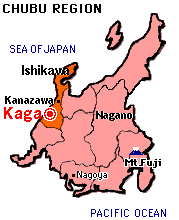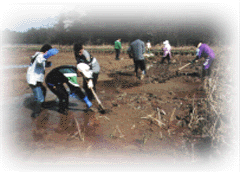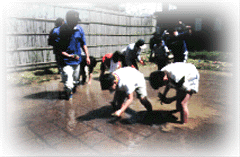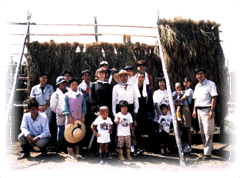

 |
|
| Geographical location |
City of Kaga
Lat. 36° 19' N
Long. 136° 17' E
Access
from Tokyo
1 hour by air to Komatsu
from Komatsu
about 2/3 hour by train
to Kaga
from Osaka
about 2 1/3 hours by train
to Kaga
|
Related links
Ishikawa Prefecture
Kaga City (Japanese only)
Kaga-city Kamoike Sanctuary
|
The Pond

The Katano Kamoike
pond (kamo means "duck" and ike means "pond") in the city of Kaga,
Ishikawa Prefecture, has been known as the winter home of many wild geese and
ducks since 300 years ago, in the Edo period (1600-1868). A water gate was built
at this time so that the water level could be lowered during the spring and
summer to use the pond as paddy fields (called tanbo in Japanese). In
the autumn, after the rice was harvested, the pond would be filled again and
become the home of many migratory birds until spring. The pond provides plenty
of food for the birds that arrive from Siberia (a region in Russia) in the autumn,
because ears of rice sprout up in the paddy fields after the harvest. Many other
creatures and plants can also be found there.
During the spring and summer, when the water
is partially drained, the size of Kamoike is about 1.5 hectares (15,000 square
meters or 17,900 square yards). When it is filled in the autumn, though, it
grows into a large pond measuring a good 9 hectares (90,000 square meters or
108,600 square yards).
 Until about 10 years ago tens of thousands
of birds spent the winter at the pond, but this number has been falling over
the past few years; when a survey was done in January 1999, only 2,540 birds
could be counted at the pond. It's thought that this has to do with the government's
agricultural policy called gentan--leaving some of the rice fields unused
to keep from making more rice than the Japanese people can use. At the pond,
too, a smaller area than before is used to grow rice, so there are fewer places
for the birds to feed.
Until about 10 years ago tens of thousands
of birds spent the winter at the pond, but this number has been falling over
the past few years; when a survey was done in January 1999, only 2,540 birds
could be counted at the pond. It's thought that this has to do with the government's
agricultural policy called gentan--leaving some of the rice fields unused
to keep from making more rice than the Japanese people can use. At the pond,
too, a smaller area than before is used to grow rice, so there are fewer places
for the birds to feed.
The people of Kaga City have been working together
for many years to protect the environment of Kamoike. And in 1993, the pond
was added to the Ramsar List of Wetlands of International Importance. This is
the official list of the Ramsar Convention,
an international treaty under which countries of the world promise to protect
wetlands that are important as the homes of water birds.
The Club
 The Kamoike Tanbo Club was organized in April
1996. Its purpose is to restore the Kamoike pond into an environment full of
various creatures and rare plants, where as many migratory birds as before pass
the winter. Adults aren't the only members; many kids who go to nearby nursery,
elementary, and middle schools have joined the club, too.
The Kamoike Tanbo Club was organized in April
1996. Its purpose is to restore the Kamoike pond into an environment full of
various creatures and rare plants, where as many migratory birds as before pass
the winter. Adults aren't the only members; many kids who go to nearby nursery,
elementary, and middle schools have joined the club, too.
One of the club's important activities is to
plant rice in the pond and make more food for the birds to eat. The kids take
part in everything from turning over the soil with hoes to harvesting the rice.
In April 1999, nearly 20 kids planted rice seedlings in the pond with the help
of farmers and schoolteachers. They went into the paddy field barefoot and did
the planting in gooey mud with water up to their knees. "The softness of the
mud feels good," said one child. Another was very excited to find tadpoles,
crayfish, and frogs in the pond.
 From summer until
October, when the water birds come from the north, the kids in the club will
be be busy preparing for the birds' arrival by weeding the paddy fields and
harvesting the rice.
From summer until
October, when the water birds come from the north, the kids in the club will
be be busy preparing for the birds' arrival by weeding the paddy fields and
harvesting the rice.
Photos: (From top) A view of Kamoike; club members prepare the field
for planting; kids planting rice; the group poses with harvested rice. (Kamoike
Observation Center)






 Until about 10 years ago tens of thousands
of birds spent the winter at the pond, but this number has been falling over
the past few years; when a survey was done in January 1999, only 2,540 birds
could be counted at the pond. It's thought that this has to do with the government's
agricultural policy called gentan--leaving some of the rice fields unused
to keep from making more rice than the Japanese people can use. At the pond,
too, a smaller area than before is used to grow rice, so there are fewer places
for the birds to feed.
Until about 10 years ago tens of thousands
of birds spent the winter at the pond, but this number has been falling over
the past few years; when a survey was done in January 1999, only 2,540 birds
could be counted at the pond. It's thought that this has to do with the government's
agricultural policy called gentan--leaving some of the rice fields unused
to keep from making more rice than the Japanese people can use. At the pond,
too, a smaller area than before is used to grow rice, so there are fewer places
for the birds to feed.  The Kamoike Tanbo Club was organized in April
1996. Its purpose is to restore the Kamoike pond into an environment full of
various creatures and rare plants, where as many migratory birds as before pass
the winter. Adults aren't the only members; many kids who go to nearby nursery,
elementary, and middle schools have joined the club, too.
The Kamoike Tanbo Club was organized in April
1996. Its purpose is to restore the Kamoike pond into an environment full of
various creatures and rare plants, where as many migratory birds as before pass
the winter. Adults aren't the only members; many kids who go to nearby nursery,
elementary, and middle schools have joined the club, too. From summer until
October, when the water birds come from the north, the kids in the club will
be be busy preparing for the birds' arrival by weeding the paddy fields and
harvesting the rice.
From summer until
October, when the water birds come from the north, the kids in the club will
be be busy preparing for the birds' arrival by weeding the paddy fields and
harvesting the rice.